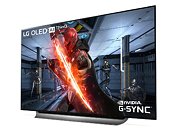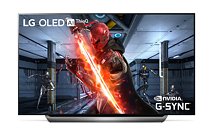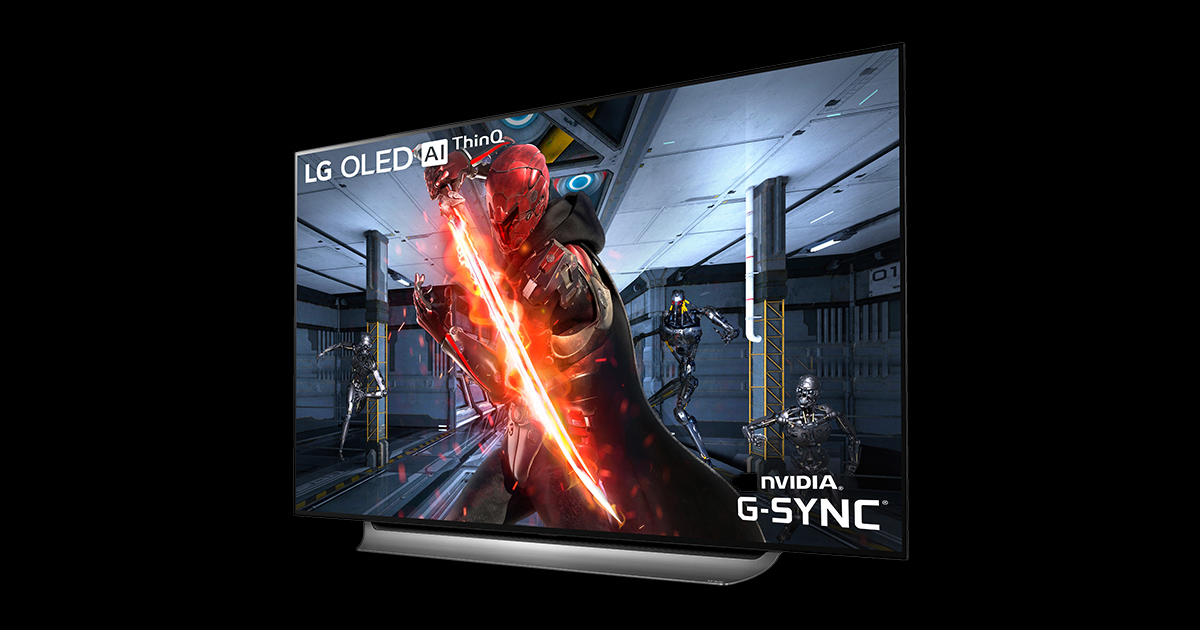- Joined
- Oct 9, 2007
- Messages
- 47,670 (7.43/day)
- Location
- Dublin, Ireland
| System Name | RBMK-1000 |
|---|---|
| Processor | AMD Ryzen 7 5700G |
| Motherboard | Gigabyte B550 AORUS Elite V2 |
| Cooling | DeepCool Gammax L240 V2 |
| Memory | 2x 16GB DDR4-3200 |
| Video Card(s) | Galax RTX 4070 Ti EX |
| Storage | Samsung 990 1TB |
| Display(s) | BenQ 1440p 60 Hz 27-inch |
| Case | Corsair Carbide 100R |
| Audio Device(s) | ASUS SupremeFX S1220A |
| Power Supply | Cooler Master MWE Gold 650W |
| Mouse | ASUS ROG Strix Impact |
| Keyboard | Gamdias Hermes E2 |
| Software | Windows 11 Pro |
LG Electronics (LG) has joined forces with NVIDIA to make gamers' dreams come true, adding support for NVIDIA G-SYNC Compatibility to its stunning 2019 OLED TVs (model 65/55E9, model 77/65/55C9). LG's newest OLED products offer blazing speed and stunning color reproduction, their superior performance and image quality validated through NVIDIA G-SYNC Compatible testing to ensure a smooth and immersive gaming experience without flickering, tearing or stuttering.
With exceptional picture quality, low input lag and an ultra-fast response time, LG OLED TVs have already earned a reputation for delivering an optimized gaming performance. The addition of NVIDIA G-SYNC Compatibility raises the bar once more, guaranteeing even more immersive big-screen PC gaming on the company's industry-leading 4K OLED models, available in 55- to 77-inch screen sizes.


LG's self-emissive OLED technology takes users deeper into the pulsating action of their favorite games, employing the precision of individual pixel control to produce incredibly realistic images. Along with infinite contrast and highly accurate color reproduction, the TVs offer an ultra-fast response time with a refresh rate of up to 120Hz. Input lag - which can make the difference between victory and defeat - is barely perceptible at a 6 milliseconds range for 1440p content at 120 Hz and 13 milliseconds range for 4K content at 60 Hz. The minimal input lag of LG's OLED TVs, of less than a frame, with no loss in picture quality, makes them the best displays for gaming.
What's more, LG's latest OLED TV models support a variety of popular HDR formats that further elevate the gaming experience. Users can play compatible titles in dynamic HDR10 or Dolby Vision (at up to 120 frames per second for Full HD content) taking advantage of HDMI 2.1 specifications such as auto low latency mode (ALLM), enhanced audio return channel (eARC), and variable refresh rate (VRR).
To heighten viewers' sense of immersion when playing games or watching fast content, LG's 2019 OLED TVs support cinematic audio formats including Dolby Atmos and groundbreaking Dolby TrueHD lossless sound technology. With the best premium audio and video format options covered, users can hear and see content as originally intended by its creators. These models also incorporate LG's deep learning-based AI sound for captivating virtual 5.1 surround.
"It's no secret LG OLED TVs are coveted by gamers world over and we are committed to optimizing the OLED gaming experience for them," Sam Kim, senior vice president of the TV product planning division of Home Entertainment company at LG. "With NVIDIA G-SYNC adoption, we are showing that OLED TVs have the support and backing of the world's top gaming hardware brand to make their products look their best."
"We are excited to bring G-SYNC Compatible support to LG's 2019 OLED TVs and HDMI Variable Refresh Rate support to our GeForce RTX 20-Series GPUs," said Matt Wuebbling, head of GeForce marketing at NVIDIA. "Gamers will be blown away by the responsiveness and the lifelike visuals on these TVs when playing the latest PC games featuring real-time ray-tracing powered by GeForce."
NVIDIA G-SYNC Compatible support for LG's 2019 OLED TVs will become available in select markets via a firmware upgrade in the weeks to follow.
View at TechPowerUp Main Site
With exceptional picture quality, low input lag and an ultra-fast response time, LG OLED TVs have already earned a reputation for delivering an optimized gaming performance. The addition of NVIDIA G-SYNC Compatibility raises the bar once more, guaranteeing even more immersive big-screen PC gaming on the company's industry-leading 4K OLED models, available in 55- to 77-inch screen sizes.


LG's self-emissive OLED technology takes users deeper into the pulsating action of their favorite games, employing the precision of individual pixel control to produce incredibly realistic images. Along with infinite contrast and highly accurate color reproduction, the TVs offer an ultra-fast response time with a refresh rate of up to 120Hz. Input lag - which can make the difference between victory and defeat - is barely perceptible at a 6 milliseconds range for 1440p content at 120 Hz and 13 milliseconds range for 4K content at 60 Hz. The minimal input lag of LG's OLED TVs, of less than a frame, with no loss in picture quality, makes them the best displays for gaming.
What's more, LG's latest OLED TV models support a variety of popular HDR formats that further elevate the gaming experience. Users can play compatible titles in dynamic HDR10 or Dolby Vision (at up to 120 frames per second for Full HD content) taking advantage of HDMI 2.1 specifications such as auto low latency mode (ALLM), enhanced audio return channel (eARC), and variable refresh rate (VRR).
To heighten viewers' sense of immersion when playing games or watching fast content, LG's 2019 OLED TVs support cinematic audio formats including Dolby Atmos and groundbreaking Dolby TrueHD lossless sound technology. With the best premium audio and video format options covered, users can hear and see content as originally intended by its creators. These models also incorporate LG's deep learning-based AI sound for captivating virtual 5.1 surround.
"It's no secret LG OLED TVs are coveted by gamers world over and we are committed to optimizing the OLED gaming experience for them," Sam Kim, senior vice president of the TV product planning division of Home Entertainment company at LG. "With NVIDIA G-SYNC adoption, we are showing that OLED TVs have the support and backing of the world's top gaming hardware brand to make their products look their best."
"We are excited to bring G-SYNC Compatible support to LG's 2019 OLED TVs and HDMI Variable Refresh Rate support to our GeForce RTX 20-Series GPUs," said Matt Wuebbling, head of GeForce marketing at NVIDIA. "Gamers will be blown away by the responsiveness and the lifelike visuals on these TVs when playing the latest PC games featuring real-time ray-tracing powered by GeForce."
NVIDIA G-SYNC Compatible support for LG's 2019 OLED TVs will become available in select markets via a firmware upgrade in the weeks to follow.
View at TechPowerUp Main Site







